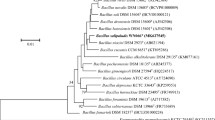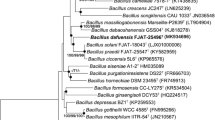Abstract
A Bacillus-like isolate, strain FJAT-13831T, isolated from the No. 1 pit soil of Emperor Qin’s Terra-cotta Warriors in Xi’an City, China, was studied to determine its taxonomic status. Dominant fatty acids of this organism included iso-C15:0, iso-C17:0, C16:0, iso-C13:0, anteiso-C15:0, and iso-C17:1ω5c. Comparative 16S rRNA gene sequence analysis confirmed the affiliation of this isolate to the genus Bacillus and indicated that it was closely related to Bacillus pseudomycoides DSM 12442T (99.72 % similarity). A phylogenetic analysis of the gyrB gene sequence similarities exhibited independent clustering of the isolate FJAT-13831T and showed 93.8 % (<95 %) sequence similarity with its closest phylogenetic neighbour B. pseudomycoides DSM 12442T. Separate standing of the strain FJAT-13831T was supported by a whole genome-based phylogenetic analysis with an average nucleotide identity value of 91.47 (<95 %) between isolate FJAT-13831T and B. pseudomycoides DSM 12442T and was consistent with the results of DNA–DNA hybridization (69.1 % relatedness). These findings support the conclusion that the isolate FJAT-13831T represents a novel species, for which the name Bacillus bingmayongensis sp. nov. is proposed. The type strain is FJAT-13831T (= CGMCC 1.12043T = DSM 25427T).

Similar content being viewed by others
References
Ahmed I, Yokota A, Yamazoe A, Fujiwara T (2007) Proposal of Lysinibacillus boronitolerans gen. nov. sp. nov., and transfer of B. fusiformis to L. fusiformis comb. nov. and Bacillus sphaericus to L. sphaericus comb. nov. Int J Syst Evol Microbiol 57:1117–1125
Atlas RM (1993) Handbook of microbiological media, 2nd edn. In: Parks LC (ed). CRC Press, Boca Raton
Baik KS, Lim CH, Park SC, Kim EM, Rhee MS, Seong CN (2010) Bacillus rigui sp. nov., isolated from wetland fresh water. Int J Syst Evol Microbiol 60:2204–2209
Bhandari V, Ahmod NZ, Shah HN, Gupta RS (2013) Molecular signatures for Bacillus species: demarcation of the B. subtilis and B. cereus clades in molecular terms and proposal to limit the placement of new species into the genus Bacillus. Int J Syst Evol Microbiol 63:2712–2726
Chen YG, Hao DF, Chen QH, Zhang YQ, Liu JB, He JW, Tang SK, Li WJ (2011) Bacillus hunanensis sp. nov., a slightly halophilic bacterium isolated from non-saline forest soil. Antonie Van Leeuwenhoek 99:481–488
Cohn F (1872) Untersuchungen über Bacterien. Beitrage zur Biologie der Pflanzen 1:127–244
De Ley J, Cattoir H, Cattoir R, Reynaert A (1970) The quantitative measurement of DNA hybridization from renaturation rates. Eur J Biochem 12:133–142
Felsenstein J (1985) Confidence limits on phylogenies: an approach using the bootstrap. Evol 40:783–791
Gatson JW, Benz BF, Chandrasekaran C, Satomi M, Venkateswaran K, Hart ME (2006) Bacillus tequilensis sp. nov., isolated from a 2000-year-old Mexican shaft-tomb, is closely related to B. subtilis. Int J Syst Evol Microbiol 56:1475–1484
Gonzalez JM, Saiz-Jimenez C (2005) A simple fluorimetric method for the estimation of DNA–DNA relatedness between closely related microorganisms by thermal denaturation temperatures. Extremophiles 9:75–79
Goris J, Konstantinidis KT, Klappenbach JA, Coenye T, Vandamme P, Tiedje JM (2007) DNA–DNA hybridization values and their relationship to whole-genome sequence similarities. Int J Syst Evol Microbiol 57:81–91
Gregersen T (1978) Rapid method for distinction of Gram–negative from Gram–positive bacteria. Eur J Appl Microbiol Biotechnol 5:123–127
Jones DT, Taylor WR, Thornton JM (1992) The rapid generation of mutation data matrices from protein sequences. Comp Appl Biosci 3:8275–8282
Jukes TH, Cantor CR (1969) Evolution of protein molecules. In: Munro HN (ed) Mammalian protein metabolism, vol 3. Academic Press, New York, pp 21–132
Jung MY, Kim JS, Paek WK, Lim J, Lee H, Kim PI, Ma JY, Kim W, Chang YH (2011) Bacillus manliponensis sp. nov., a new member of the B. cereus group isolated from foreshore tidal flat sediment. J Microbiol 49:1027–1032
Kämpfer P, Blasczyk K, Auling G (1994) Characterization of Aeromonas genomic species by using quinone, polyamine, and fatty acid patterns. Can J Microbiol 40:844–850
Kaneda T (1977) Fatty acids of the genus Bacillus: an example of branched-chain preference. Bacteriol Rev 41:391–418
Kim OS, Cho YJ, Lee K, Yoon SH, Na H, Kim M, Park SC, Jeon YS, Lee JH, Yi H, Won S, Chun J (2012) Introducing EzTaxon–e: a prokaryotic 16S rRNA gene sequence database with phylotypes that represent uncultured species. Int J Syst Evol Microbiol 62:716–721
Konstantinidis KT, Tiedje JM (2005a) Genomic insights that advance the species definition for prokaryotes. Proc Natl Acad Sci USA 102:2567–2572
Konstantinidis KT, Tiedje JM (2005b) Towards a genome based taxonomy for prokaryotes. J Bacteriol 187:6258–6264
La Duc MT, Satomi M, Agata N, Venkateswaran K (2004a) gyrB as a phylogenetic discriminator for members of the Bacillus anthracis-cereus-thuringiensis group. J Microbiol Methods 56:383–394
La Duc MT, Satomi M, Venkateswaran K (2004b) Bacillus odysseyi sp. nov., a round-spore-forming Bacillus isolated from the Mars Odyssey spacecraft. Int J Syst Evol Microbiol 54:195–201
Larkin MA, Blackshields G, Brown NP, Chenna R, McGettigan PA, McWilliam H, Valentin F, Wallace IM, Wilm A, Lopez R, Thompson JD, Gibson TJ, Higgins DG (2007) Clustal W and Clustal X version 2.0. Bioinformatics 23(21):2947–2948
Liu B, Liu GH, Lin NQ, Tang JY (2012a) Bacillus identification and phylogenetic analysis, isolated from the 1st pit soil of Emperor Qin’s Terracotta Warrior. Fujian J Agric Sci 27:563–573
Liu GH, Liu B, Lin NQ, Tang WQ, Tang JY, Lin YZ (2012b) Genome sequence of the aerobic bacterium Bacillus sp. strain FJAT-13831. J Bacteriol 194:6633
Logan NA, Berkeley RCW (1984) Identification of Bacillus strains using the API system. J Gen Microbiol 130:1871–1882
Nazina TN, Lebedeva EV, Poltaraus AB, Tourova TP, Grigoryan AA, Sokolova DSH, Lysenko AM, Osipov GA (2004) Geobacillus gargensis sp. nov., a novel thermophile from a hot spring, and the reclassification of Bacillus vulcani as Geobacillus vulcani comb. nov. Int J Syst Evol Microbiol 54:2019–2024
Owen RJ, Hill LR (1979) The estimation of base compositions, base pairing and genome size of bacterial deoxyribonucleic acids. In: Skinner FA, Lovelock DW (eds) Identification methods for microbiologists (Society for Applied Bacteriology Technical Series no. 14), 2nd edn. Academic Press, London, pp 277–296
Priest FG (1993) Systematics and ecology of Bacillus. In: Sonenshein AL, Hoch JA, Losick R (eds) Bacillus subtilis and other Gram-positive bacteria—Biochemistry, physiology, and molecular genetics. ASM press, American Society for Microbiology, Washington. ISBN 1-55581-053-5
Priest FG, Goodfellow M, Todd C (1988) A numerical classification of the genus Bacillus. J Gen Microbiol 134:1847–1882
Saitou N, Nei M (1987) The neighbor-joining method: a new method for reconstructing phylogenetic trees. Mol Biol Evol 4:406–425
Sambrook J, Fritschi EF, Maniatis T (1989) Molecular cloning: a laboratory manual. Cold Spring Harbor Laboratory Press, New York
Sasser M (1990) Identification of bacteria by gas chromatography of cellular fatty acids. In: Klement S, Rudolf K, Sands D (eds) Methods in phytobacteriology. Akademiai Kiado, Budapest, pp 199–204
Satomi M, Kimura B, Hamada T, Harayama S, Fujii T (2002) Phylogenetic study of the genus Oceanospirillum based on 16S rRNA and gyrB genes: emended description of the genus Oceanospirillum, description of Pseudospirillum gen. nov., Oceanobacter gen. nov. and Terasakiella gen. nov. and transfer of Oceanospirillum jannaschii and Pseudomonas stanieri to Marinobacterium as Marinobacterium jannaschii comb. nov. and Marinobacterium stanieri comb. nov. Int J Syst Evol Microbiol 52:739–747
Satomi M, Oikawa H, Yano Y (2003) Shewanella marinintestina sp. nov., Shewanella schlegeliana sp. nov. and Shewanella sairae sp. nov., novel eicosapentaenoic acid-producing marine bacteria isolated from sea-animal intestines. Int J Syst Evol Microbiol 53:491–499
Satomi M, Kimura B, Hayashi M, Okuzumi M, Fujii T (2004) Marinospirillum insulare sp. nov., a novel halophilic helical bacterium isolated from kusaya gravy. Int J Syst Evol Microbiol 54:163–167
Satomi M, La Duc MT, Venkateswaran K (2006) Bacillus safensis sp. nov., isolated from spacecraft and assembly facility surfaces. Int J Syst Evol Microbiol 56:1735–1740
Schleifer KH, Kandler O (1972) Peptidoglycan types of bacterial cell walls and their taxonomic implications. Bacteriol Rev 36:407–477
Smibert RM, Krieg NR (1994) Phenotypic characterization. In: Gerhardt P, Murray RGE, Wood WA, Krieg NR (eds) Methods for general and molecular bacteriology. American Society for Microbiology, Washington, pp 607–654
Sorokin A, Candelon B, Guilloux K, Galleron N, Wackerow-Kouzova N, Ehrlich SD, Bourguet D, Sanchis V (2006) Multiple-locus sequence typing analysis of B. cereus and B. thuringiensis reveals separate clustering and a distinct population structure of psychrotrophic strains. Appl Environ Microbiol 72:1569–1578
Stackebrandt E, Ebers J (2006) Taxonomic parameters revisited: tarnished gold standards. Microbiol Today 33:152–155
Stackebrandt E, Goebel BM (1994) Taxonomic note: a place for DNA–DNA reassociation and 16S rRNA sequence analysis in the present species definition in bacteriology. Int J Syst Bacteriol 44:846–849
Stackebrandt E, Liesack W (1993) Nucleic acids and classification. In: Goodfellow M, O’Donnell AG (eds) Handbook of new bacterial systematics. Academic Press, London, pp 152–189
Takami H (2007) Genomic diversity of Bacillus-related species. Nova Science Publisher, New York. ISBN 978-1-–60456–396–2
Talavera G, Castresana J (2007) Improvement of phylogenies after removing divergent and ambiguously aligned blocks from protein sequence alignments. Syst Biol 56(4):564–577
Tamura K, Nei M, Kumar S (2004) Prospects for inferring very large phylogenies by using the neighbor-joining method. PNAS 101:11030–11035
Tamura K, Peterson D, Peterson N, Stecher G, Nei M, Kumar S (2011) MEGA5: molecular evolutionary genetics analysis using maximum likelihood, evolutionary distance, and maximum parsimony methods. Mol Biol Evol 28(10):2731–2739
Thompson JD, Gibson TJ, Plewniak F, Jeanmougin F, Higgins DG (1997) The CLUSTAL_X windows interface: flexible strategies for multiple sequence alignment aided by quality analysis tools. Nucleic Acids Res 25:4876–4882
Vanlaere E, Baldwin A, Gevers D, Henry D, De Brandt E, LiPuma JJ, Mahenthiralingam E, Speert DP, Dowson C, Vandamme P (2009) Taxon K, a complex within the Burkholderia cepacia complex, comprises at least two novel species, Burkholderia contaminans sp. nov. and Burkholderia lata sp. nov. Int J Syst Evol Microbiol 59:102–111
Venkateswaran K, Dohmoto N, Harayama S (1998) Cloning and nucleotide sequence of the gyrB gene of Vibrio parahaemolyticus and its application in detection of this pathogen in shrimp. Appl Environ Microbiol 64:681–687
Venkateswaran K, Moser DP, Dollhopf ME, Lies DP, Saffarini DA, MacGregor BJ, Ringelberg DB, White DC, Nishijima M (1999) Polyphasic taxonomy of the genus Shewanella and description of Shewanella oneidensis sp. nov. Int J Syst Bacteriol 49:705–724
Wang LT, Lee FL, Tai CJ, Kasai H (2007) Comparison of gyrB gene sequences, 16S rRNA gene sequences and DNA–DNA hybridization in the B. subtilis group. Int J Syst Bacteriol 57:1846–1850
Wayne LG, Brenner DJ, Colwell RR, Grimont PAD, Kandler O, Krichevsky MI, Moore LH, Moore WEC, Murray RGE (1987) International committee on systematic bacteriology. Report of the ad hoc committee on reconciliation of approaches to bacterial systematics. Int J Syst Bacteriol 37: 463–464
Yamamoto S, Harayama S (1995) PCR amplification and direct sequencing of gyrB gene with universal primers and their application to the detection and taxonomic analysis of Pseudomonas putida strains. Appl Environ Microbiol 61:1104–1109
Zhang L, Wu GL, Wang Y, Dai J, Fang CX (2011) Bacillus deserti sp. nov., a novel bacterium isolated from the desert of Xinjiang, China. Antonie Van Leeuwenhoek 99:221–229
Acknowledgments
We are grateful to Dr. Jean P. Euzeby (Society for Systematic and Veterinary Bacteriology, France) for his advice on nomenclatural queries and Dr. Peter Schumann (DSMZ, Germany) for his contribution to the analysis of the cell wall composition of the strain FJAT-13831T. This work was supported by the National fund projects (31370059), by the National Key Project of Fundamental Scientific Research (“973” Program, No. 2011CB111607), by the project of Agriculture Science & Technology Achievement Transformation (No. 2010GB2C400220), by the program of International Science & Technology Cooperation (No. 2012DFA31120), by Agro-scientific Research in the Public Interest (No. 201303094), and by the national “948” project (No. 2011-G25) from the Chinese Ministry of Agriculture.
Author information
Authors and Affiliations
Corresponding author
Electronic supplementary material
Below is the link to the electronic supplementary material.
Rights and permissions
About this article
Cite this article
Liu, B., Liu, GH., Hu, GP. et al. Bacillus bingmayongensis sp. nov., isolated from the pit soil of Emperor Qin’s Terra-cotta warriors in China. Antonie van Leeuwenhoek 105, 501–510 (2014). https://doi.org/10.1007/s10482-013-0102-3
Received:
Accepted:
Published:
Issue Date:
DOI: https://doi.org/10.1007/s10482-013-0102-3




